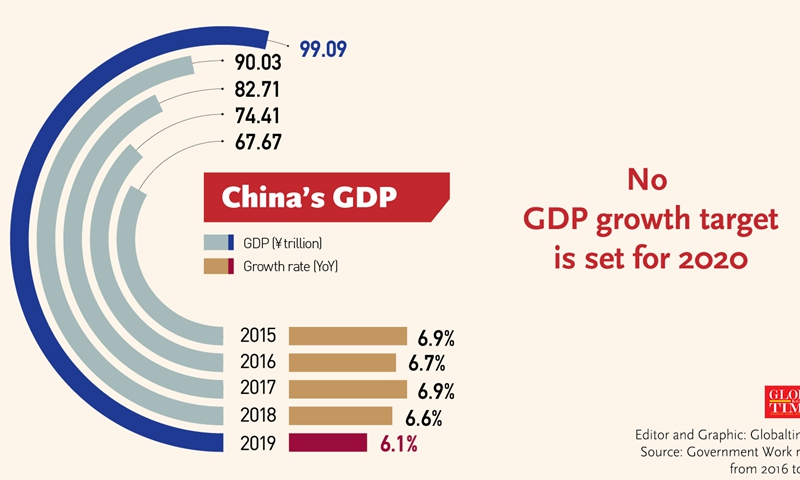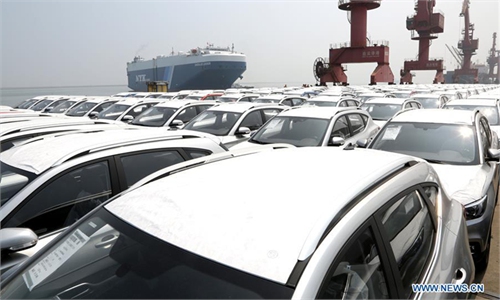China to downplay GDP growth target in new five-year plan: economists
China to focus on high-tech independence to prepare for long-term fight with US

Cover-GDP 2020
Ahead of a key meeting that will determine China's development path in the next five years, Chinese economists predicted that the country's policymakers will downplay the country's GDP growth target in its new economic plan, keeping it at a lower level of around 5 percent, or even scrap the specific target since the world's second-largest economy is set to drop the quantity-oriented growth model and focus on structural and quality optimization in the face of what could be the "toughest years" ahead.
The Political Bureau of the Communist Party of China (CPC) Central Committee met on Monday to review a report on public consultations on a CPC document on the formulation of the 14th Five-Year Plan (2021-25) for Economic and Social Development, and targets for 2035.
The document, after being revised based on opinions raised at the meeting, will be submitted for deliberation at the Fifth Plenary Session of the 19th CPC Central Committee in Beijing from October 26 to 29, where the leaders are expected to discuss and approve China's economic and social development blueprint for 2021-2025.
A GDP growth target has always been a highlight of the plan.
For its 13th Five-Year Plan that ends this year, China targeted an average annual growth of at least 6.5 percent. The 12th Five-Year Plan's (2011-15) target was 7 percent.
"China will surely downplay the GDP growth target this time, amid the shift in China's development phase and a complicated external environment. It's also reasonable to set a lower target since China has moved to an innovation and investment-driven growth pattern," Lian Ping, head of the Zhixin Investment Research Institute, told the Global Times on Tuesday.
"A 4.5 percent growth target is highly possible," Hu Qimu, a senior fellow at the Sinosteel Economic Research Institute, predicted.
"It is also likely that China won't peg a GDP growth target, as there has been a shift in the philosophy of policymakers, where rapid growth no longer speaks of the strength of the Chinese economy," Wang Yiwei, a professor at the School of International Relations of Renmin University of China, told the Global Times on Tuesday.
"China did not set a GDP target this year, which shows that Beijing could have abandoned the so-called 6-percent 'bottom line.' What Beijing is pursuing is to enhance core competitiveness and create more jobs amid a lengthy economic transition," Wang explained.
In May, China scrapped a numerical economic growth target in 2020 for the first time in decades, amid a heavy blow from the coronavirus crisis.
China has so far proven it could withstand the headwinds. In the second quarter, China's economy grew by 3.2 percent, reversing a 6.8 percent contraction in the first quarter. It was also a sign of the resilience deeply rooted in China's economy amid a global freefall, when the coronavirus pandemic plunged most major economies into a near standstill.
The World Bank projected that China could achieve a growth of 2 percent this year, boosted by government spending, strong exports and a low rate of new coronavirus infections since March. The rest of East Asia and the Pacific region are projected to see a 3.5 percent contraction.
"If the global pandemic is controlled soon, we have every reason to believe China's GDP can achieve growth of about 8 to 10 percent in 2021," Lian said.
'Toughest moment'
Nevertheless, analysts said this year, which witnessed growing challenges fueled by a deepening rift between China and the US, and the COVID-19 pandemic will just be the beginning of a tough test for China's economy.
"China will experience tremendous difficulties in the next 10 to 15 years. Intensifying China-US relations, risks of the reemergence of the pandemic, and a global economic downturn will pose challenges to China's economic development, and make the 14th five-year plan more important than ever," Lian said.
US factors, such as measures to prepare for an intense tussle with the US, will likely account for as much as 30 percent in the next five-year plan, Hu said, noting that China has to be prepared for a long-term fight with the US crackdown and its decoupling threat.
An emphasis of a dual cycle development pattern, strong policy support for the high-tech sector even if it means huge costs in the short-term, and continuous opening-up will be included in the plan, Lian predicted.
The 2021-2025 period will also be a critical stage for China, as a developing nation, to inch closer to the economies of developed nations, or even significantly narrow the gap with the US, the world's largest economy, experts said.
Tian Yun, vice director of the Beijing Economic Operation Association, told the Global Times on Tuesday that as long as China expands its GDP by $1 trillion per year in the next 15 years, Washington will be forced to abort its conspiracy against Beijing.
"If we achieve a GDP of $30 trillion by 2035, we could see a domestic market twice as large as that of the US. With an economy underpinned by internal factors, we will be able to repulse US aggression in a tit-for-tat manner," Tian noted.
Lin Yifu, honorary dean of the National School of Development at Peking University, predicted that China's GDP will surpass that of the US by 2030, based on exchange rates, and could be twice the US' by 2050.
Another focus of the plan for the next five years is to help China's remaining one billion residents become part of the middle class, analysts said.
Whatever the international and domestic situation will be, China will become a high-income country, with an average per capita GDP exceeding the $12,700 threshold, if we can remain focused on our strategy, and put our growth potential in full play, Lin was quoted as saying in media reports.
"If China can 'survive,' which means maintaining four percent growth in the next five to 10 years, then China can counter potential external challenges, and also successfully overcome the so-called middle-income trap," Lian said.
Chi Jingyi contributed to the story




